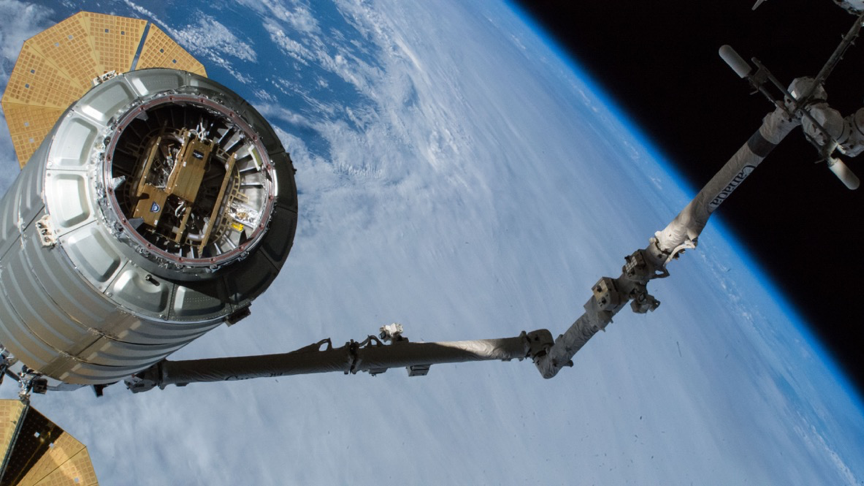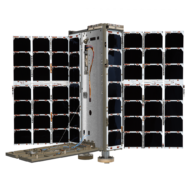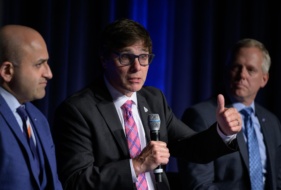Last month, Lynk claimed a first: two-way satellite-to-smartphone connectivity. The breakthrough was not the connection, but that Lynk satellites communicated with ordinary, unmodified phones. Phones were talking to satellites without any special satellite receiver.
Lynk is negotiating contracts with mobile carriers and preparing for Gen-1 satellite production, CEO Charles Miller tells Payload. You can find the full interview below.
NB: This interview was edited for brevity and length. Also, MNO = mobile network operator.
Tell us about your technology demonstration in September.
We had a world first in 2020: the first emergency cell broadcast message from a satellite to mobile phones on the ground. This time, we’ve repeatedly registered hundreds of phones per minute on our satellite network.
Registering a phone is difficult. You must get the ID and verify it’s on the network. You have to be able to hear through all the noise, which is the hard part. A phone is a little, low-power device.
We’ve proven that we can register phones through a lot of noise without causing harmful interference. There’s two MNOs monitoring the system during our overpasses on the Eastern seaboard. It’s not knocking tons of people off the network.
What have you learned so far from the two-way testing?
Even here in the Eastern seaboard of the US, along the East coast, there’s tens of millions of phones. Some are in black spots, and they’re disconnected. A lot of the MNOs claim there is no disconnectivity in the eastern US. Well, tell that to the phones who are asking to be connected to our satellite.
Back when you were just getting things off the ground, figuratively and literally, what did you see that others didn’t?
All the things that people said weren’t possible five years ago have now been proved. We looked at the physics five, six years ago. We knew how to do it several years ago, but we had to prove it from a satellite in space. Now we’ve done that with our satellite.
Can you say a bit about what’s novel with this technology? And specifically, the ability to connect satellites and unmodified, off-the-shelf phones?
That’s the holy grail. People said: ‘Oh, you can’t do it.’
I’ll explain how we do it. The key is backward compatibility with the global standard on phones, 3GPP. Almost every country in the world comports to this standard. It’s like the internet’s TCP protocol. With our equipment, we want to look to a phone on the ground like a cell tower using the 3GPP protocol. It has to look like it. That is the hard challenge we started on five years ago.
We started with off-the-shelf standard software—the base station software that’s in the cell tower. After we solved for closing the link, we have to solve two more things to make the satellite look like a cell tower. The satellite has to be in low LEO [low-Earth orbit], which means it’s coming and going very fast—25,000 kilometers per hour. It’s not geostationary orbit. There’s a very high doppler shift, which rapidly changes, when you start talking to a phone. The phone can tolerate bullet train speeds like 200 or 300 kilometers per hour. It can’t tolerate anywhere near what we’re seeing from the satellite.
The protocol is intentionally designed to not talk to a cell tower that’s beyond 35km for 2G or 100km for LTE. We’re 500–700km up. We instantly detect how much doppler shift there is; we know our exact orbit and where we’re going. So we know how far away the phone is.
When we tell the phone what channel to talk on, we do doppler compensation and offset that at the satellite ‘cell tower’ level. The phone doesn’t see any of that. There’s also a time delay, and by the time the two are linked, if the phone thinks the satellite is too far away, it’s supposed to break the connection.
So our satellite lies to the phone and says ‘I’m right next to you.’ Not ‘I’m 700km away.’ It spoofs the phone and pretends like it’s 5km away. That smartphone in your pocket? It’s actually a dumb phone in this case. It trusts cell towers to say where they are.
In this way, we are backward-compatible with every existing mobile phone on the planet that’s 2G, 3G, 4G, or LTE. And in the future, 5G as well. The modifications we make for doppler shift and time delay work for all the protocols.
Can you say what sorts of services and applications would be supported by your satellites in the near-term?
We’ve plotted our growth on a crawl, walk, run strategy, like what Intel did with microprocessors. They reinvested profits from old generations into the new ones. By the time you got to the Pentium, you’ve started a virtuous cycle. Our virtuous cycle is as clear as Moore’s Law. The roadmap shows exponential growth in capacity and speeds over time. We can do the fastest speeds in your phone, upwards of 100 megabits per second, down the road. But that’s not where we start.
Right, because your network wouldn’t be able to serve as many devices. What’s the target market for this?
Our market research suggests that about 15% of existing mobile users are disconnected at any point. They’re hitting black spots. This tends to be farmers, fishers, hunters, hikers, and people living in rural communities. If you live overseas in an emerging market, you’re also much more likely to be disconnected.
15% doesn’t sound big until you multiply it by 5.2 billion people. So 750 million people are disconnected at any point in time. Plus, over a period of a year, our market research says that 60% of all those mobile users experience one or more periods of extended disconnectivity. It’s great that 40% don’t experience any, but there’s still over three billion people who do.
Then, there’s the next billion. In emerging markets, many families only buy one phone for the household. They go in on weekends to a village to send and receive messages and do a few phone calls, but that’s it. The moment you get affordable connectivity everywhere, all the family members would be more likely to buy a phone.
You won’t be giving anyone broadband speeds at the outset.
Right. Technically, we could. The satellite we have in orbit today has the technical capability to do 10 megabits per second to a phone in the center of the beam. But doing that is very capacity-limiting.
And that’s the dirty little secret, even for Starlink or Viasat. Viasat has no more capacity on their broadband geosynchronous satellites. Elon’s satellites have a capacity limit. We’re capacity-limited too. If we let people do voice or broadband data from our satellite, they suck up all the capacity and nobody else can get on.
What about at scale?
Remember the 750 million people we talked about? We need about 1,500 satellites for global coverage. Divide and that’s about 600,000 people per satellite. That swamps our network. No cell tower anywhere in the US today can handle 600,000 people.
We have to parse out the bandwidth we have, for both business and ethical reasons. Everyone gets a little bit of connectivity, rather than giving some people more connectivity and knocking everyone else off. Take a five-minute voice call. We can do 5,000 or 10,000 SMS messages instead.
The opportunity cost is pretty huge.
If we give someone a voice call, and we’re capacity-limited, it means we’re knocking 5,000–10,000 others off the network.
What’s the thinking on how you’ll charge for messages?
Our market research suggests we can charge 10 cents a message. That’s $500-$1,000 in revenue for the messages. But nobody would pay $500-$1,000 for a five minute voice call. Before WhatsApp and iMessage gave you messaging for free, but before that people were used to paying 10–20 cents for a message. People will do that if it’s the only way to send a message.
That’s how we’re going to market, with messaging. It will finance everything and make sure everyone’s connected.
The other reason we have to do messaging? If you knock 5,000 people off the network so one dude can do a voice call, and one of them dies because they weren’t connected, that’s just wrong. We’re not just doing this to make money—we also want to change and save lives. We have to make sure that everybody has some connectivity, before we allow other people to start using more bandwidth.
Once we have enough capacity, we’ll be able to flip a switch and add voice or data. We’ll eventually offer those higher value use cases.
Makes sense. What are the biggest drivers in unlocking more capacity?
Building a whole network of 1,500+ satellites. And building more powerful, complex satellites. But they cost more. If I had Elon money, I’d jump to Gen 2 or 3 instantly. But I don’t have Elon money, so we’ll start out with Gen 1, then make Elon money, then finance Gen 2 and reinvest back in the network. We’ll create this virtuous cycle.
For your flagship carrier program, how do you evaluate and assess who you may work with?
Dozens and dozens of MNOs want to test with us. But we’re one company. It’s very clear we can’t test with everyone. We’ve decided to only test with carriers who sign a contract with us. On top of that, we’ll give preference to the people who are ready to go the fastest.
We’re going to give the flagship carriers preferential treatment. We’ll focus on a dozen of them. And those companies are the ones willing to lean forward and work with us to make our service work in their country. These carriers will get de facto exclusivity in their country for a certain time period.
Beyond speed, are there any other criteria for where you’re looking? Mobile penetration rates? Specific geographical regions?
It factors in less on our side, and more so for MNOs. In South Korea, everything is basically covered. We’ve talked to South Korean MNOs. They’ve said ‘yes, some day we’ll use this,’ but it’s not a big, burning need. The countries that have more need are generally quicker to move.
What are you focused on over the next few months?
We’re raising our next round of funding and then we’ll accelerate production of our Gen 1 system. We’re planning to begin commercial service next July. We’ve already signed up four MNOs. Finally, we’ve filed our FCC application.
How was that process?
We received a few comments. It was very striking, though, that none of the MNOs opposed our application. They all stayed silent. It looks like they kind of actually like what we’re doing. We’re in the comment period now, and then knock on wood, get an FCC signoff and start the service here real quickly. (Editor’s note: he did actually knock on wood.)
Any parting thoughts on where you fit within the new space economy?
I love Elon. I met him 20 years ago. And this is how old I am—I told him he should start a rocket company. He looked at me and said he had no interest in starting one. So that’s how old I am—pre-SpaceX. I love what he’s done, but this is the thing about Starlink: There’s only 3 million high-throughput satellite customers in the world today. If Elon gets 10 million for Starlink, he’s doing wonderful. That’s a great business—$1 billion of revenue a month.
His market is 10x smaller than my market. He has 10 million customers in that scenario; I’m going after 4 billion. Two orders of magnitude more subscribers that we serve. That’s the contrast of how big Starlink could be as a business, compared with how big Lynk could be.
Did you catch the Morgan Stanley note from earlier this week?
I remember seeing some quote about how he’s going to become the first trillionaire.
That’s right; that was the headline. But in the actual meat of the report, there was an interesting projection about ~80% of Starlink’s buildout costs being user terminals. That’s not part of the equation for you, right?
We have no user terminal costs. The cost of subscriber acquisition is driven by the user terminal. You already have our user terminal! Say we sign up Verizon as a partner. They do an over-the-air update to your phone; that’s like 100 million phones at the same time. So the economics here are pretty unbelievable.
Last question. In the same way that you’re not really competing with SpaceX, I suppose you also aren’t competing with 5G or fiber?
No. Wherever you have coverage, you’re going to use it. We’re not competing with Elon. Starlink’s terminal has an 18-inch antenna. That’s way bigger than the antenna in your phone. Starlink will always be faster than us.
But the moment you walk out of a wi-fi hotspot, you’re not going to bring that 18-inch antenna with you. You’ll have your phone. In that respect, we are completely complementary to Viasat and Starlink. They’re competing against fiber and each other, and cable systems that give you Wi-Fi. But we’re a completely new category.




